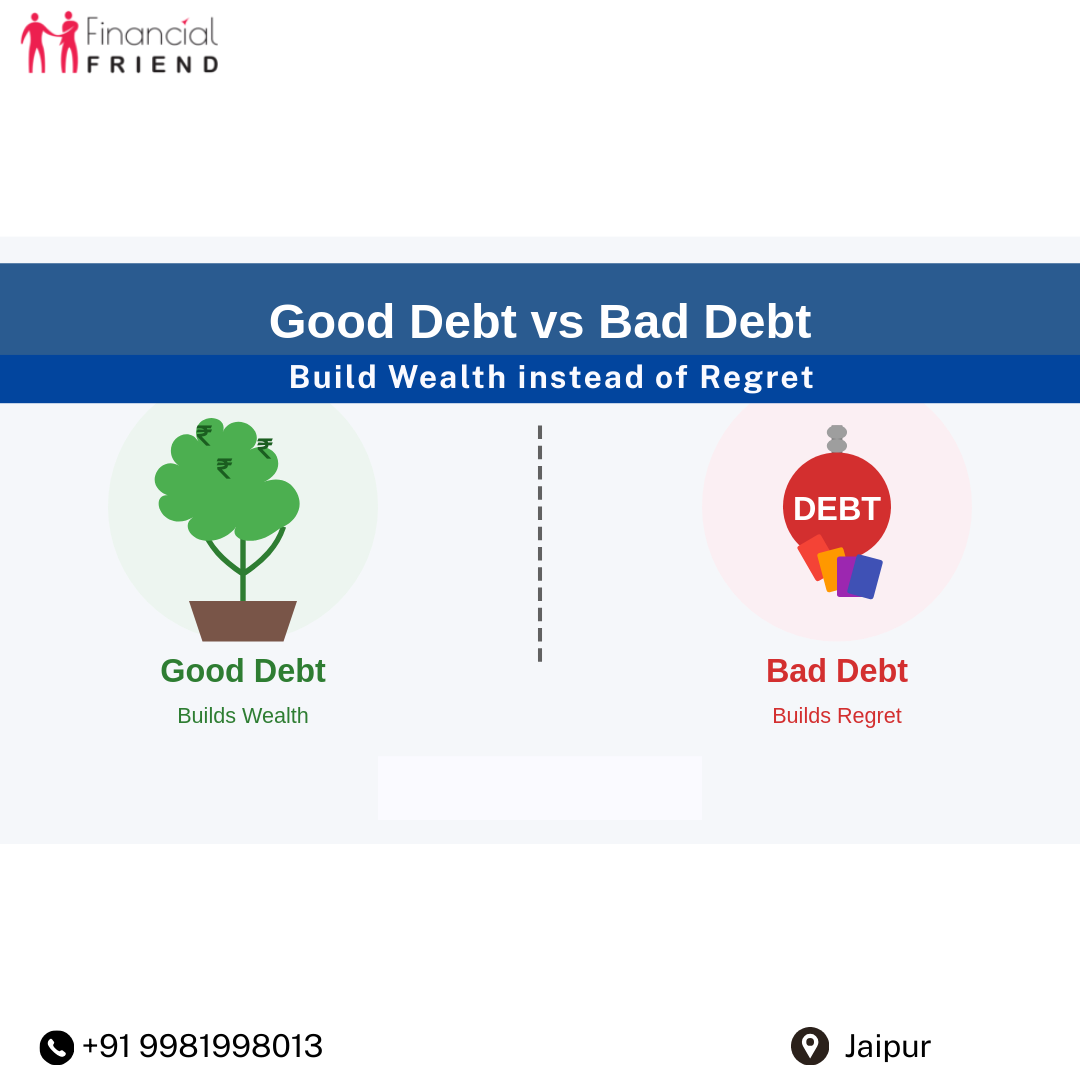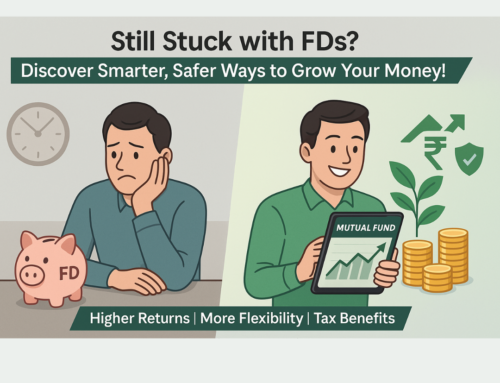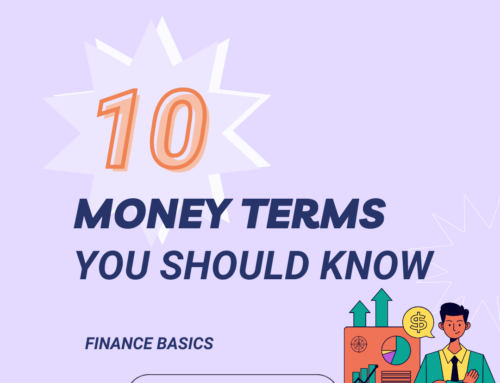“Save money, avoid debt at all costs!”
We’ve all heard this advice from our parents and grandparents. But here’s a surprising truth I’ve learned after years as a financial planner in Jaipur: not all debt is created equal. Some can actually help you build wealth, while other types can keep you awake at night with worry.
What Is Good Debt?
Is an investment. It helps you grow your wealth or improve your financial future. It’s the kind of debt that supports goals like:
- Higher Education: An education loan that increases your earning potential.
- Home Loan: Buying a home that appreciates in value.
- Business Loan: Funding your business to generate future income.
Benefits of Good Debt:
- Low-interest rates (like home loans)
- Tax benefits (such as Section 80C or 24(b))
- Long-term asset creation
Good debt = borrowing with a clear purpose and plan to repay.
What Is Bad Debt?
It is any debt that drains your finances and doesn’t create value. It’s usually taken for instant gratification rather than long-term gain.
Example:
- Credit card for shopping, gadgets, vacations
- Personal loans for luxury items
- Loan EMIs that exceed your monthly savings
Why It Hurts:
- High interest rates
- No asset creation
- Can lead to a debt trap
Bad debt = borrowing for lifestyle, not value.
How to Stay Smart with Loan Payments
- Always ask: Will this debt help me grow?
- Avoid using credit for wants — use it for needs and growth.
- Keep EMIs below 30-40% of your income.
- Maintain a good credit score to access good debt options.
Let me share a story about two friends from Jaipur – Raj and Vikram.
A Tale of Two Debts
Raj and Vikram each borrowed ₹10 lakh in 2020. Five years later, their financial situations couldn’t be more different.
Raj used his loan as a down payment on a small apartment in Jagatpura. Today, his property has appreciated by 25%, he’s built equity through his payments, and he’s earning rental income that covers most of his EMI. Plus, he’s enjoying tax benefits that effectively reduce his interest rate.
Vikram used credit cards and personal loans to fund an extravagant wedding, a luxury honeymoon, and a fancy car. Today, he’s still drowning in debt, has paid nearly ₹7 lakh in interest alone, and the things he purchased have either depreciated or are just memories.
Same amount borrowed. Dramatically different outcomes.
What Makes Debt “Good” or “Bad”?
It’s simple: Good debt puts money in your pocket over time. Bad debt takes money out of your pocket over time.
Let’s break this down with real examples I’ve seen with my clients right here in Jaipur.
Good Debt: Your Ladder to Financial Growth
Home Loans: Building Wealth While Building a Home
My client Meera purchased a ₹40 lakh apartment in Malviya Nagar with a home loan in 2018. Her monthly EMI is about ₹32,000, similar to what she would have paid in rent.
Today, her apartment is worth ₹52 lakh, she’s built almost ₹9 lakh in equity, and she’s saved approximately ₹1.2 lakh in taxes through home loan deductions. Meanwhile, her friend who kept renting has nothing to show for her monthly payments.
The wealth-building magic: Property appreciation + equity building + tax benefits + inflation protection
Education Loans: Investing in Your Earning Power
Priya was earning ₹25,000 monthly at a BPO when she decided to pursue an MBA. She took an education loan of ₹8 lakh, studied hard, and landed a job paying ₹85,000 monthly after graduation.
Within two years, she had repaid her loan completely. Now she earns over ₹1.2 lakh monthly – a lifelong return on that initial debt.
The wealth-building magic: Dramatically increased earning potential + career advancement opportunities
Business Loans: Funding Your Dream (When Done Right)
My client Amit ran a small spice shop in Johari Bazaar. He took a ₹5 lakh loan to expand his business online during the pandemic. Today, his monthly profits have tripled, and he’s repaid the loan entirely.
The debt was temporary, but the increased business capacity is permanent.
The wealth-building magic: Increased income potential + asset creation + tax benefits on business expenses
Bad Debt: The Silent Wealth Killer
Credit Card Debt: The Deceptively Dangerous “Plastic Money”
Did you know a ₹1 lakh credit card balance at 42% interest (common in India) would take 10+ years to repay if you only make minimum payments? You’d end up paying over ₹3 lakh on your original ₹1 lakh balance!
I’ve seen clients in Jaipur who treat credit cards like free money, using them for restaurant meals, shopping trips, and vacations. When the bills come due, they make only minimum payments, falling deeper into a debt trap each month.
The wealth-killing trap: Astronomical interest rates + easy to ignore growing balances + minimum payment illusion
Expensive Car Loans: The Status Symbol That Drains Your Wealth
A new car loses 20-30% of its value the moment you drive it off the lot. Yet I regularly see people in Jaipur taking 7-year loans for luxury cars they can’t really afford.
My client Rohan financed a ₹14 lakh car over 7 years. Three years in, the car is worth ₹8 lakh, but he still owes ₹9.5 lakh on it. He’s literally underwater on the loan – owing more than the asset is worth!
The wealth-killing trap: Rapid depreciation + long loan terms + high interest rates + additional costs (insurance, maintenance)
“Instant” Personal Loans: Quick Money, Long-Term Pain
Those “instant” personal loans advertised everywhere in Jaipur? They’re often charging 18-24% interest or more.
Sunita took a ₹2 lakh personal loan for her daughter’s wedding. Three years later, she’s still making payments and has paid nearly ₹1 lakh in interest alone.
The wealth-killing trap: High interest rates + emotional borrowing decisions + consumption rather than investment
Real Talk: How to Make Smart Decisions
Let me share five practical tips I give my clients:
1. Apply the “Sleep Test”
If your debt keeps you awake at night with worry, it’s probably bad debt. Good debt helps you sleep better knowing you’re building something valuable.
2. Ask: “Will this purchase be worth more or less in 5 years?”
If less (like most consumer goods), avoid debt to buy it. If more (like property or education), debt might be appropriate.
3. Follow the 50-30-20 Rule
Keep your essential expenses, including debt payments, under 50% of your take-home pay. This prevents overextending yourself, even with “good” debt.
4. Create an Emergency Fund First
Many bad debt traps start with unexpected expenses. Having 3-6 months of expenses saved means you won’t need to borrow at high interest rates when emergencies strike.
5. Refinance Strategically
Already carrying high-interest debt? Look into converting it to lower-interest options. I recently helped a client in Jaipur consolidate five high-interest loans into one affordable EMI.
How Small Decisions Compound: The 10-Year Difference
Let me share a real example from two of my clients – both young professionals earning similar salaries:
Riya prioritized a home loan and investment property, leveraging “good debt” strategically. After 10 years, she owns property worth ₹95 lakh with just ₹40 lakh in remaining loans.
Aditya used credit cards and personal loans for lifestyle expenses. After 10 years, he has zero assets to show for it and still carries ₹18 lakh in high-interest debt.
Same starting point, dramatically different destinations – all because of how they used debt.
Take This 5-Minute Debt Check-Up
Ready to assess your own situation? Grab a paper and pen:
- List every debt you have with its interest rate
- Mark each as “builds wealth” or “costs wealth” based on what you’ve learned
- Calculate how much of your monthly income goes to debt payments
- Circle the highest-interest debts – these are your priority to eliminate
- Identify any “good debt” opportunities you might be missing
Your Next Steps: From Debt Stress to Financial Freedom
The path to financial freedom isn’t avoiding all debt – it’s being strategic about which debts you take on and why.
Here I’ve seen clients transform their financial futures simply by shifting from bad debt to good debt. The family that stopped financing depreciating assets and instead invested in rental property. The young professional who paid off credit cards and used that freed-up cash flow to fund a side business.
These aren’t financial theories – they’re real results from real people right here.
Need help crafting your personal loan management strategy? That’s exactly what we specialize in at Financial Friend. We’ll help you create a plan to eliminate wealth-draining debts and strategically use wealth-building debts when appropriate.
Visit www.financialfriend.in or 📞 call us at +91 9981998013 for a free 30-minute session. Together, we’ll make sure you are building your wealth, not someone else’s.
Disclaimer: This article provides general information based on real client experiences (with names changed for privacy). Individual situations vary, and specific recommendations require personal consultation.





